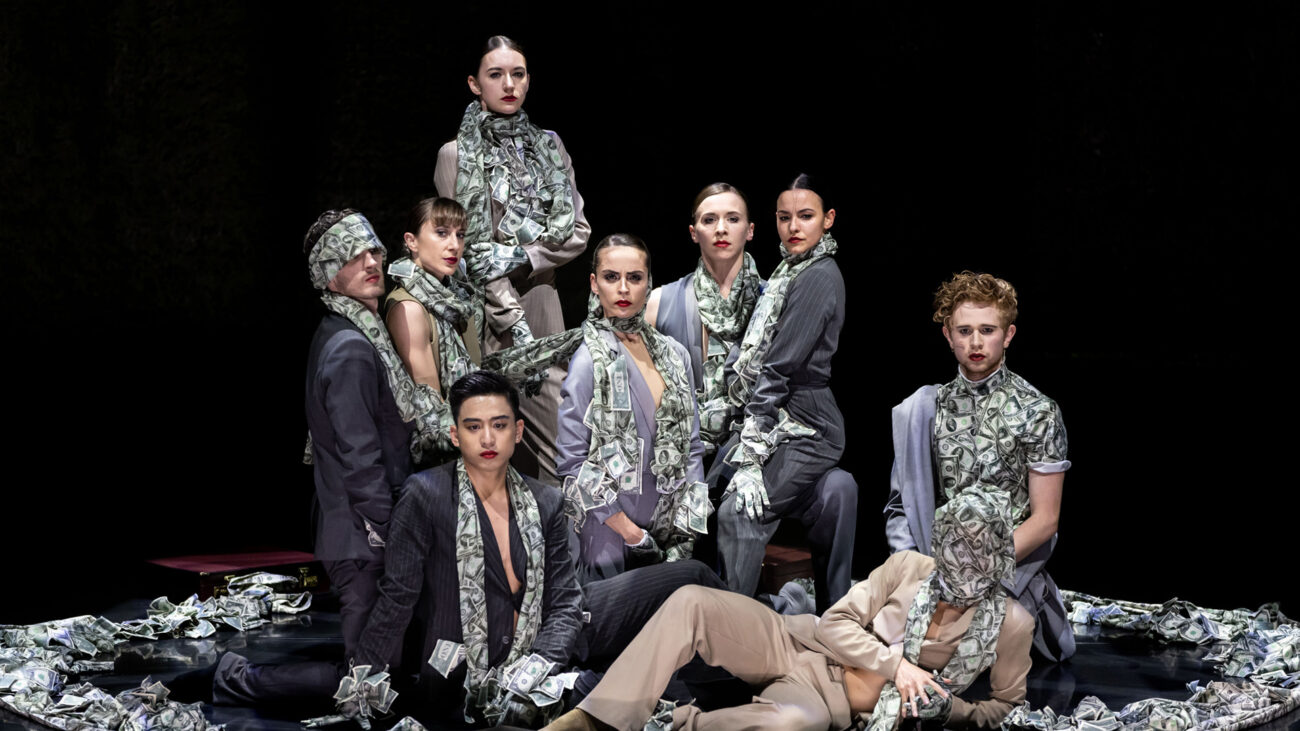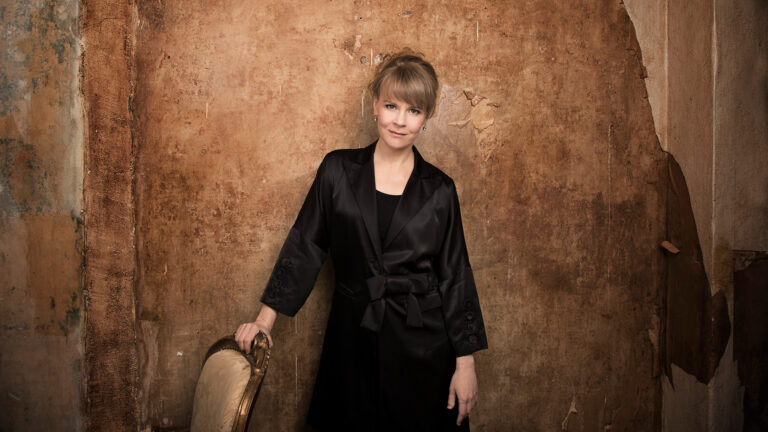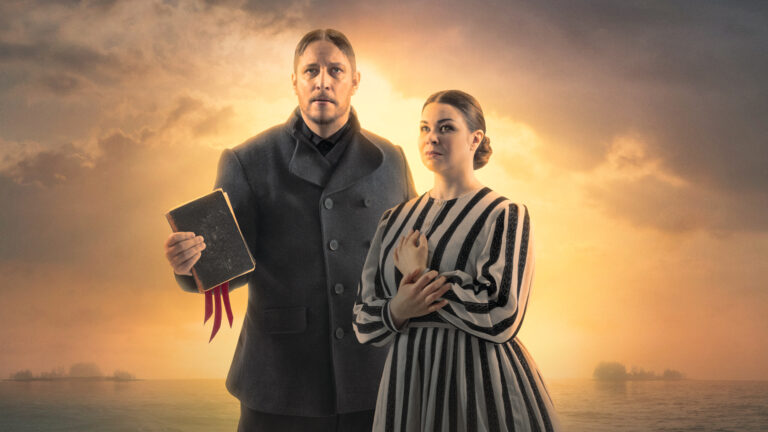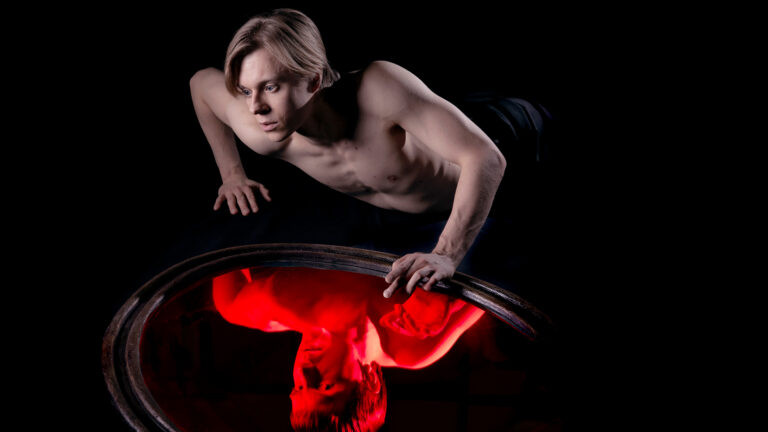Gauthier Dance: The Seven Sins (GER)
Teoksessa seitsemän maailmankuulua koreografia muuntavat kukin yhden kuolemansynnin tanssiteokseksi.

Tietoa tapahtumasta
Liput 56 €
Eläkeläiset 46 €
Työttömät 36 €
Lapset ja nuoret (alle 16-vuotiaat) ja opiskelijat 25 €
Seitsemän kuolemansyntiä seitsemän huippukoreografin tulkintoina!
Tampereella päästään nauttimaan eurooppalaisesta nykytanssista, kun saksalainen Gauthier Dance//Dance Company Theaterhaus Stuttgart vierailee Tampere-talossa upean vastaanoton saaneella The Seven Sins -teoksellaan. Teoksessa seitsemän maailmankuulua koreografia muuntavat kukin yhden kuolemansynnin tanssiteokseksi.
The Seven Sins tarjoaa ainutlaatuisen mahdollisuuden tutustua tämän päivän puhutuimpien koreografien teoksiin yhden illan aikana. Koreografioista vastaavat Aszure Barton (laiskuus), Sidi Larbi Cherkaoui (ahneus), Sharon Eyal (kateus), Marco Goecke (ylensyönti), Marcos Morau (ylpeys), Hofesh Shechter (himo) ja Sasha Waltz (viha).
Teoksessa tanssivat Bruna Andrade, Andrew Cummings, Anneleen Dedroog, Karlijn Dedroog, Barbara Melo Freire, Shai Ottolenghi, Luca Pannacci, Garazi Perez Oloriz, Rina Pinsky, Arnau Redorta Ortiz, Izabela Szylinska, Sidney Elizabeth Turtschi, Locke Egidio Venturato, Giovanni Visone, Shawn Wu ja Shori Yamamoto.
”Hämmästyttävä. Loistava.” – Les Echos, Ranska
”The Sevens Sins sopii hyvin kaikille, jotka etsivät katsausta nykypäivän tanssitrendeihin.” – Stuttgarter Zeitung, Saksa
”– liikuttavia ja ravisuttavia tulkintoja moraalisista ja abstrakteista teemoista. Täynnä energiaa ja aistillisuutta.” –
Wolfsburger Nachrichten, Saksa
Kesto 1 h 45 minuuttia. Ei väliaikaa.
Huom! Tapahtumassa on lisäkatsomo.
Esityksessä käytetään voimakkaita valo- ja ääniefektejä sekä näyttämösavua.
Muutokset mahdollisia.
Tuotanto Tampere-talo
Tietoa esiintyjistä
Gauthier Dance
Eric Gauthier perusti Gauthier Dancen vuonna 2007, ja ryhmä on sen jälkeen vakiinnuttanut asemansa saksalaisessa ja kansainvälisessä tanssikentässä ennätysnopeasti. Gauthier Dance esittää nykytanssia Gauthierilta itseltään sekä kansainvälisesti tunnetuilta nykykoreografeilta.
Tekijät
Taiteellinen johtaja: Eric Gauthier
Koreografit: Aszure Barton, Sidi Larbi Cherkaoui, Marco Goecke, Sharon Eyal, Marcos Morau, Sasha Waltz, Hofesh Shechter
Balettimestarit: Cesar Locsin, Luis Eduardo Sayago
Tuotanto ja hallinto: Inga Kunz
Tekninen tuotanto: Mario Daszenies, Holger Reuker
Pukujen taiteellinen koordinointi: Gudrun Schretzmeier
Lavastussuunnittelu: Mario Daszenies
Musiikki: Victoria Hillestad & Julian Erhardt / [sic]-studios
Taiteellinen tuotanto: Daria Mosunova, Susanne Wildermuth
Tiedotus: Nicola Steller
Kiertue: ecotopia dance productions
Puvut: Kerry Rees (Head), Christine Lange, Katharina Ruprecht, Katja Strauss, Anne Sorvat, Aische Weber, Maria Kley
Tuotanto: Theaterhaus Stuttgart
Yhteistuotanto: Venetsian biennaali ja Festspiele Ludwigshafen & Theater im Pfalzbau
Yhteistyössä: SWR / ARTE & Euro Arts
Ensi-ilta: 7. toukokuuta 2022, Theaterhaus Stuttgart
Koreografit
Nykytanssista klassiseen balettiin, oopperasta ja Broadway-musikaaleista musiikkivideoihin, elokuvaan ja teatteriin – Sidi Larbi Cherkaouita on vaikea kuvata yksiselitteisesti. Hän on tehnyt yhteistyötä Beyoncén kanssa, ohjannut barokkiooperoita sekä moderneja teoksia kuten Philip Glassin töitä, koreografioinut Alanis Morissette -teemaisen Broadway-musikaalin vuonna 2019 sekä useita suuria Hollywood-elokuvia, kuten viimeksi Joe Wrightin elokuvan Cyrano. Hänen koreografioidensa teemat käsittelevät suuria inhimillisiä myyttejä sekä tiedon ja viisauden etsintää. Cherkaoui nousi ensimmäisen kerran tanssitaivaan tähdeksi hämmästyttävän notkeana esiintyjänä, ja pian sen jälkeen tuotteliaana koreografina, jolla on ainutlaatuinen kyky luoda maailmoja, joissa liike, musiikki ja arkkitehtuuri sulautuvat saumattomasti yhteen. Hänen työnsä ovat keränneet hämmästyttävän määrän palkintoja ja ehdokkuuksia, mukaan lukien kaksi Olivier-palkintoa, kolme Tanz-palkintoa, Giraldillo-palkinto sekä Kairos-palkinto. Cherkaoui johtaa vuonna 2010 perustamaansa nykytanssiryhmää Eastmania, jonka lisäksi hän toimi Ballet Vlaanderenin taiteellisena johtajana vuosina 2015–2022. Kesäkuusta 2022 lähtien Sidi Larbi on toiminut Geneven Grand Théâtren baletin johtajana.
From contemporary dance to classical ballet, from opera and broadway musicals to music videos, film and theater. Sidi Larbi Cherkaoui defies easy description. He worked with Beyonce, staged baroque operas as well as modern works by Philip Glass, he choreographed an Alanis Morisette themed broadway musical in 2019 and several major hollywood film productions like most recently for director Joe Wright’s film Cyrano. His work always stayed close to theatre. His themes include the great myths of humanity and its search for knowledge and wisdom. Cherkaoui appeared first on the dance firmament as a startlingly limber performer, and, immediately after, as a prolific choreographer with a remarkable ability to create worlds entirely to themselves, worlds where movement and music and architecture meld seamlessly. His work has picked up a staggering number of prizes and nominations, including two Olivier Awards, three Tanz Awards, a Giraldillo Award, and the Kairos Prize for his services to art and culture. While artistic director of Eastman, his own contemporary dance company founded in 2010, Cherkaoui also helmed the Ballet Vlaanderen (Ballet of Flanders) between 2015 and 2022. SInce June 2022, Sidi Larbi is director of the Ballet of the Grand Theatre de Geneve.
Aszure Barton rakastaa klassista tanssia, mutta vielä enemmän hän rakastaa sen rajojen rikkomista. Hänen leikittelevä ja joskus jopa absurdin teatraalinen tyylinsä liikkuu unen ja todellisuuden välimaastossa. Barton luo mystisiä liikkeitä pienistä, arkisista eleistä ja yhdistää elegantisti erilaisia tanssityylejä toisiinsa. Kanadalainen tanssija saa inspiraationsa tanssijoidensa yksilöllisyydestä, työskennellen ihmisten, ei pelkästään heidän kehojensa kanssa. Aszure Barton syntyi Edmontonissa, aloitti steppitanssin lapsena ja opiskeli samaan aikaan Kanadan kansallisessa balettikoulussa yhdessä Eric Gauthierin kanssa. 16-vuotiaana hän oli mukana käynnistämässä koulussa koreografista työpajaa, joka on yhä toiminnassa. Myöhemmin hän matkusteli ympäri Eurooppaa tutustuen monenlaisiin koreografisiin tyyleihin. Vuonna 2002 hän perusti oman ryhmänsä, Aszure Barton & Artists. Vuonna 2005 Mikhail Baryshnikov nimitti hänet ensimmäiseksi residenssitaiteilijaksi uuteen tanssikeskukseensa New Yorkissa. Barton on luonut teoksia monille kansainvälisille ryhmille, kuten Nederlands Dans Theaterille, American Ballet Theatrelle ja Martha Graham Dance Companylle. Hänen koreografioita on nähty myös Broadwaylla, esimerkiksi Kolmen pennin oopperassa, jonka pääosissa olivat Cyndi Lauper ja Alan Cumming. Saksassa Barton on koreografioinut Baijerin valtionbaletille ja saavuttanut suurta menestystä Ballett am Rheinissa teoksellaan Baal, joka on vapaasti sovitettu Bertolt Brechtin mukaan.
Even more than classical dance, Aszure Barton loves breaking out of it – with a flair for imagery and a sometimes absurd theatricality, her freeflowing style dances between dream and reality. She creates mysterious movements out of small, everyday gestures, elegantly blending different styles into one another. The Canadian dancer draws inspiration from the individuality of her dancers, working with people, not only with their bodies. Aszure Barton was born in Edmonton, started tap dancing as a child and studied at Canada’s National Ballet School at the same time as Eric Gauthier. At 16, she helped kickstart a choreographic workshop for students there which still exists today. She later traveled throughout Europe, where she became acquainted with the wide variety of choreographic language. In 2002 she founded her own company, Aszure Barton & Artists. And in 2005, Mikhail Baryshnikov made her the first artist in residence at his new dance center in New York. She has created works for many international companies including Nederlands Dans Theater, American Ballet Theatre and Martha Graham Dance Company. Other choreography credits include the Broadway production of The Threepenny Opera starring Cyndi Lauper and Alan Cumming, In Germany, Barton has choreographed for the Bavarian State Ballet and had great success at the Ballett am Rhein with Baal, freely adapted from Bertolt Brecht.
Mitä Salvador Dalí oli maalaustaiteelle ja Luis Buñuel elokuvalle, sitä heidän maanmiehensä Marcos Morau on tanssille. Hänen teoksensa esittävät surrealistisia, erikoisen kauniita kuvia – tanssin, taiteen, arkkitehtuurin, tekstin ja musiikin arvoituksellisia maailmoja. Morau yhdistää symboleja perinteisiin, antaa taideteosten kommunikoida yli ajan sekä tuo tanssiin filosofiaa, mytologiaa ja uskontoa. Marcos Morau on opiskellut valokuvausta, koreografiaa ja dramaturgiaa; hänelle tanssi on teatraalinen väline, jolla liikkeen avulla katsotaan kuvien taakse. Vuonna 2005 hän perusti taiteilijakollektiivinsa La Veronalin, jossa hän toimii ohjaajana, koreografina, dramaturgina tai lavastus-, puku- tai valaistussuunnittelijana riippuen esityksestä. Barcelonasta alkaen Moraun fantastinen ja surrealistinen tanssiteatteri on valloittanut maailman, ja hän on luonut teoksia myös monille muille eurooppalaisille ryhmille. Hän on kaikkien aikojen nuorin Espanjan kansallisen tanssipalkinnon voittaja.
What Salvador Dali was to painting and Luis Bunuel to film, their compatriot Marcos Morau is to dance: his pieces present surreal images of outlandish beauty, enigmatic worlds of dance, art, architecture, text and music. Morau relates symbols to traditions, he allows works of art to communicate across time, brings philosophy, mythology and religion into dance and stages a theatre of the body amidst spectacular imagery. Marcos Morau studied photography, choreography and dramaturgy; for him dance is a theatrical means of using movement to look behind the images. In 2005 he founded his artist collective La Veronal, with whom he works as a director, choreographer, dramaturge or a stage, costume or lighting designer, depending on the piece in question. Starting in Barcelona, Morau’s fantastical, surreal dance theater has conquered the world, and he has also created works for many other European companies. He is the youngest ever winner of Spain’s National Dance Award, conferred in recognition of his unique combination of performance, theatre and dance. Morau also teaches at universities, where he gives classes on his unique dramaturgy.
Marco Goecke on tämän vuosituhannen toistaiseksi vaikutusvaltaisin saksalainen koreografi. Goecken tummasävyisten teosten liikekielen värinä ja lepatus häiritsevät ja kiehtovat. Hän keskittyy koreografioissaan ensisijaisesti ylävartaloon, erityisesti käsivarsiin ja käsiin, joille hän on avannut uuden ilmaisun universumin. Hänen kuvansa ovat usein pelottavia, mutta Goecken rikas mielikuvitus tuottaa myös runollisia ja hilpeitä hetkiä. Älyllisellä tasolla saatamme tuntea houkutusta tulkita hänen lyhyitä kuviaan ja viittauksiaan lineaarisesti, mutta ehkä ne on parempi ymmärtää alitajunnan kautta.
Marco Goecken ensimmäinen teos syntyi vuonna 2000. Hän on toiminut residenssikoreografina sekä Stuttgartin baletissa että Rotterdamin Scapino-baletissa, ja tällä hetkellä hän on Hannoverin valtionoopperan baletin johtaja. Hän on luonut yli 80 teosta ja on kysytty vieraileva koreografi Saksan ja Euroopan suurimmissa tanssiryhmissä. Vuosina 2019–2023 hän toimi Gauthier Dance -ryhmän residenssitaiteilijana. Tähän mennessä hän on luonut ryhmälle kahdeksan teosta, mukaan lukien kokoillan teokset NIJINSKI ja Do You Love Gershwin?. Marco Goecke palkittiin Jiří Kyliánin nimikkosormuksella vuonna 2022. Kyliánin mukaan nimetty palkinto annetaan joka toinen vuosi henkilölle, joka tuo tanssiin tärkeitä uusia impulsseja.
He is the most influential German choreographer of the new millennium so far and has developed his own distinctive dance language. Marco Goecke’s dark pieces are permeated by startling associations; their nervous trembling and fluttering disturb and fascinate. He choreographs primarily for the upper body, for arms and hands, to which he has opened up a new universe of expressive possibilities. His images are often frightening, but Goecke’s rich imagination also gives rise to poetic and jovial moments. On an intellectual level we may feel compelled to subject the choreographer’s many brief images and allusions to a linear reading, but perhaps they are better understood on a subconscious level. Marco Goecke‘s first piece was created in 2000. He has been resident choreographer at both the Stuttgart Ballet and the Scapino ballet in Rotterdam, and he is currently the ballet director at the Hannover State Opera. He has created over 80 pieces and is a sought-after guest choreographer for the major German and European dance companies. From 2019 until 2023 he was Artist in Residence at Gauthier Dance. The eight pieces he has created so far for the latter include the full-length works NIJINSKI and Do You Love Gershwin?. Marco Goecke was honored with the Jiři Kylian Ring in 2022. The award, named after the first recipient Jiři Kylian, is passed on every two years to another person who gives dance important new impulses.
Hofesh Shechterin teoksissa ei esiinny abstrakteja, väänneltyjä kehoja, vaan nykypäivän ihmisiä – ihmisiä, joita voisimme kohdata kadulla, vihaisia nuoria suurkaupunkien betonin ja pölyn keskellä. Shechter näkee vihan takana piilevän tyhjyyden, aggression takana olevan surun, ja tutkii ihmisyyden pimeää puolta, sen tulevaisuutta ja tuhoa. Hänen tanssinsa on raakaa, vapaata ja dynaamista, ja sen vaikutteina ovat muun muassa juutalainen kansanperinne, jossa yhteisöllisyys ja yhteenkuuluvuus ovat keskeisiä. Shechter halusi alun perin tulla rockmuusikoksi, ja hän säveltää usein musiikin teoksiinsa. Hän käyttää voimakkaita rytmejä, jotka valtaavat tanssijoiden koko kehon.
Shechter on kotoisin Jerusalemista ja tanssi israelilaisessa Batsheva Dance Companyssa. Muutettuaan Englantiin hänen meteoriittimainen nousunsa Lontoon monimuotoisessa tanssikentässä johti sellaisten teosten syntymiseen kuin Uprising ja Political Mother, jotka ovat tehneet hänestä tunnetun ympäri maailmaa. Vuonna 2008 hän perusti Hofesh Shechter Companyn ja kiertää säännöllisesti suurilla kiertueilla uusien teostensa kanssa; hänen koreografioitaan esittävät myös monet muut ryhmät. Kesästä 2021 lähtien ja teoksensa Swan Cake ensi-illan jälkeen Hofesh Shechter on toiminut Gauthier Dance -ryhmän residenssitaiteilijana.
His pieces do not feature abstract, contorted bodies, but rather the people of today, people we could encounter on the street, angry young people in the concrete and dust of the big cities. Hofesh Shechter sees the emptiness behind the anger, the sadness behind the aggression, he inquires into the dark side of humanity, its future, its destruction. His dance is raw, free and dynamic, and its influences include Jewish folklore with its sense of community and cohesion. Shechter actually wanted to become a rock musician and very often composes the music for his pieces, employing powerful rhythms that take hold of his dancers’ entire bodies and reverberate in the groups that drift back and forth across the stage. The choreographer is from Jerusalem and danced in the Israeli Batsheva Dance Company. After moving to England, his meteoric rise in London’s diverse dance scene saw him create pieces such as Uprising and Political Mother, which have made him famous all over the world. In 2008, he founded the Hofesh Shechter Company and regularly goes on major tours with his new works; his choreographies are also performed by numerous other companies. Since the summer of 2021 and the premiere of his work Swan Cake, Hofesh Shechter has been Artist in Residence with Gauthier Dance.
Sasha Waltz on erittäin arvostettu saksalaisella nykytanssin kentällä. Kapinallinen avoimuus on aina ollut osa Waltzin estetiikkaa. Hänen uransa on kulkenut vaikuttavista intiimeistä esityksistä suurien teattereiden ja museoiden lavoille. Koreografi on kotoisin Karlsruhesta. Opiskeltuaan Amsterdamissa ja New Yorkissa hän muutti Berliiniin, missä hän perusti ryhmänsä Sasha Waltz & Guests vuonna 1993. Berliinissä hän on tehnyt koreografioita Sophiensaleen, Schaubühne am Lehniner Platziin ja Radialsystemiin. Näiden teatterien ja keskusten perustajajäsenenä tai taiteellisena johtajana hän on jatkuvasti avannut uusia näkökulmia kulttuurille.
Waltz työstää teoksia usein dialogissa tanssijoiden, muusikoiden, arkkitehtien ja yleisönsä kanssa. Hänen tuotantonsa muun muassa Berliinin valtionoopperassa ovat muovanneet koreografisen oopperan genreä. Waltz on Berliinin taideakatemian jäsen, ja Ranskassa hänelle on myönnetty ”Commandeur de l’ordre des Arts et des Lettres” -kunniamerkki.
She is an icon of contemporary dance in Germany. The rebellious openness of the independent scene where she began is still part of Sasha Waltz‘s aesthetic. From the intimate impressiveness of early successful pieces such as Allee der Kosmonauten and Körper, her career path has led her to large theaters and the vast spaces of famous museums. An important part of her creative process is the research she conducts in the form of collaboration with her dancers. The choreographer comes from Karlsruhe and after studying in Amsterdam and New York moved to Berlin, where she founded her company Sasha Waltz & Guests in 1993. In the German capital, she has choreographed works for the Sophiensale, the Schaubuhne am Lehniner Platz and Radialsystem, and, as co-founder or artistic director of these theaters and centers, she has constantly opened up new perspectives for culture. With her constantly evolving Dialogues format, Waltz seeks exchange with artists, musicians, architects, and her audiences; new pieces are often based on research conducted within the framework of these dialogues. With her productions at the Berlin State Opera, among other venues, she has shaped the genre of choreographic opera. Waltz is a member of the Berlin Academy of Arts and has been appointed “Commandeur de l‘ordre des Arts et des Lettres” in France.
Sharon Eyal syntyi Jerusalemissa ja asuu Ranskassa. Hän tanssi Batsheva Dance Companyssa vuosina 1990–2008. Eyal toimi Batshevan taiteellisena apulaisjohtajana vuosina 2003–2004 ja talon koreografina vuosina 2005–2012. Hän loi sinä aikana talolle 16 uutta teosta.
Vuonna 2009 Eyal alkoi luoda teoksia muille tanssiryhmille ympäri maailmaa. Vuonna 2013 Eyal perusti L-E-V-ryhmän pitkäaikaisen yhteistyökumppaninsa Gai Beharin kanssa. Eyal on tehnyt yhteistyötä myös muotitalojen kanssa, kuten Christian Dior Couturen ja Maria Grazia Chiurin muotinäytöksissä ja projekteissa.
Sharon Eyal on saanut Ranskan tasavallan ”Knight of the Order of Arts and Letters” -kunniamerkin sekä Ranskan ammattiliiton tanssi- ja teatterikriitikkojen palkinnon Chaillot’n kansallisteatterissa Pariisissa (2017).
Sharon Eyal was born in Jerusalem and based in France. She danced with the Batsheva Dance Company between 1990- 2008. Eyal served as Associate Artistic Director for Batsheva from 2003–04, and as a House Choreographer for the company from 2005–12. During her time with the company, she created 16 new creations.
During 2009 Eyal began creating pieces for other dance companies around the world. In 2013 Eyal launched L-E-V with her long-time collaborator Gai Behar. Since August 2022, L-E-V is a registered non-profit French Association, basing its activity in France.
Eyal has collaborated with major names out of the traditional dance world such as Christian Dior Couture and Maria Grazia Chiuri for various fashion shows and projects, The National and Mike Milles album/movie – participating in 2 music videos for the songs ‘Hairpin Turns’ and ‘Hey Rosey’ from the album ‘I Am Easy To Find’ as well as a live performance for their international tour’s opening concert at the L’Olympia in Paris and the music label – young.
Sharon Eyal has been awarded a Knight of the Order of Arts and Letters of the French Republic as well as The French Professional Association of Dance & Theater Critiques at the Chaillot National Theater in Paris (2017).
Teosesittelyt
Greed — Corrupt
Money, specifically dollars, is the focus of Sidi Larbi Cherkaoui’s piece: “Money is the element that translates greed – the concreteness of it, the convention of money, the way we accept its power, its function.” Cherkaoui’s piece depicts a world where money can buy everything and we see businesspeople acting in an increasingly invasive fashion: “They constantly take whatever they want from another person.” Greed is fundamentally in everyone, the choreographer says; it never really disappears, it sometimes intensifies. Peace and tranquility exist only for those who find distance from money. “I hope there is also another kind of greed – the greed to become one with the universe, to connect with the bigger picture.”
Raha, etenkin setelit, ovat Sidi Larbi Cherkaouin teoksen keskiössä. ”Raha ilmentää ahneutta – rahan konkreettinen muoto, miten hyväksymme sen vallan ja tarkoituksen.”
Ahneus — Corrupt
Cherkaouin teoksessa, jossa rahalla voi ostaa kaiken, näemme pukuihin pukeutuneen joukon käyttäytyvän yhä tunkeilevammin. ”He ottavat toiselta sen, mitä itse haluavat.” Ahneus on perimmiltään jokaisessa, koreografi sanoo; se ei koskaan täysin häviä, vaan ajoittain voimistuu. Rauha ja tyyneys ovat olemassa vain niille, jotka saavat etäisyyttä rahaan. ”Toivon, että on olemassa myös toisenlaista ahneutta – ahneutta sulautua yhdeksi ja löytää yhteys maailmankaikkeuden ja suuremman kokonaisuuden kanssa.”
Choreography / Koreografia: Sidi Larbi Cherkaoui
Assistant choreographer / Koreografin assistentti: Robbie Moore
Costume Design / Pukusuunnittelu: Veerle Van de Wouwer
Lighting Design / Valosuunnittelu: Mario Daszenies
Music Composer / Musiikki: Alexandre Dai Castaing
Musicians /Muusikot: Julia Kent (Cello),
Loup Barrow (Crystal Bachet), Alice Duport-Percier (Vocal), Kelli Ali (Vocal),
Arnaud Vernet (Vocal), Christian Kleiner (Double Bass)
Sloth — human undoing
For Aszure Barton, the most devastating is the death of one’s spirit. “It’s like the sacred being sucked out of a balloon. Left unchecked, our physical, emotional, and intellectual sloth can cripple not only our bodies and minds but our souls as well. It’s when the spirit is depleted that we have no purpose. Sloth can be infuriating – it extinguishes our inner fire and leaves us empty.” Barton’s work explores broader interpretations of acedia, such as weariness, and depicts the body as a hollowed-out shell. “What interests me is our drive to do less and how this manifests physically through form. I feel like, through technology, we humans have become lazier, moving closer to a detachment from our own purpose and humanity,” says the choreographer. However, for all its weightiness and its sense of being dragged down, Barton has aimed to create a work that is deeply physical and beautifully human.
Laiskuus — human undoing
Aszure Bartonille kamalinta on ajatus sielun kuolemasta. ”Kuin pyhä olisi imetty ulos ilmapallosta. Fyysinen, emotionaalinen ja älyllinen laiskuutemme voi rampauttaa kehomme ja mielemme lisäksi myös sielumme. Jos sielu on tyhjä, ei meillä ole tarkoitusta. Laiskuus voi olla raivostuttavaa – se sammuttaa sisäisen liekin ja jättää meidät tyhjiksi”. Bartonin teos tutkii kehoa onttona kuorena. ”Olen kiinnostunut ihmisten halusta tehdä vähemmän ja tutkia, miten tämä voi ilmentyä fyysisessä muodossa. Tuntuu, että teknologian kautta olemme tulleet laiskemmiksi ja etääntyneet omasta tarkoituksestamme ja inhimillisyydestämme”, sanoo koreografi. Laiskuuden raskaasta ja alas painavasta voimasta huolimatta hän on pyrkinyt luomaan teoksen, joka on hyvin fyysinen ja kauniin inhimillinen.
Choreography & Costumes / Koreografia ja pukusuunnittelu: Aszure Barton
Lighting Design / Valosuunnittelu: Mario Daszenies
Music / Musiikki: Craig Taborn
Pride– HERMANA
Pride is the absence of doubts: a cold determination not to ask about others and an arrogance that borders on violence. Those who doubt themselves are human and can accept mistakes, says Marcos Morau. The quintet of women who perform almost ritualistically here employ a sharp and almost inexplicable conformity of movement.They have power and control; They don‘t look at anything but themselves. They don‘t look around, they just look ahead. In their clothing, their gesture, their vehemence there is a certain religiosity. They may even be motivated by a political idea, a radical thought, a tradition to which they blindly adhere. The piece also reveals the positive side of pride: autonomous women who move forward with confidence and defy time. The boundaries between arrogance and pride, between self-importance and self-confidence are not clearly discernible, and the audience must constantly redefine them for themselves.
Ylpeys – HERMANA
Ylpeys on epäilysten poissaoloa: kylmää määrätietoisuutta olla kyselemättä muiden perään, väkivaltaa lähentelevää omahyväisyyttä. “He, jotka epäilevät itseään, ovat inhimillisiä ja pystyvät hyväksymään myös virheensä”, Marcos Morau sanoo. Teoksessa nähtävä naisviisikko esiintyy lähes rituaalisesti ja on liikkeissään terävä ja lähes selittämättömän yhteneväinen. Heillä on valta ja kontrolli; he eivät katso kuin itseään. He eivät katsele ympärilleen, ainoastaan eteenpäin. Esiintyjien vaatetuksessa, eleissä ja kiihkossa on eräänlaista uskonnollisuutta. Heitä saattaa työntää eteenpäin jokin poliittinen idea, radikaali ajatus tai perinne, josta he sokeasti pitävät kiinni. Teos paljastaa myös ylpeyden myönteisen puolen: joukon itsenäisiä, itsevarmasti eteneviä naisia, jotka uhmaavat aikaa. Rajoja ylimielisyyden ja ylpeyden sekä omahyväisyyden ja itsevarmuuden välillä ei voi selkeästi havaita, ja katsojan on jatkuvasti määriteltävä ne uudelleen itse.
Direction & Costumes / Ohjaus ja pukusuunnittelu: Marcos Morau
Lighting Design / Valosuunnittelu: Mario Daszenies
Music / Musiikki: Juan Cristóbal Saavedra
Choreographic Assistants /Koreografin assistentit: Shay Partush, Marina Rodriguez
Gluttony – Yesterday‘s Scars
When gluttony was declared a deadly sin, it was still very much related to eating. Anyone who did not share their bread with the hungry made a mockery of Christian charity. Such self indulgence degraded man to the level of animals. Today those who give in to gluttony tend to be seen as undisciplined in relation to themselves; gluttony has taken on a figurative sense of uncontrolled consumption. Marco Goecke also regards it as an addiction “with alcohol and drugs in mind, of course.” The choreographer does not seek to represent gluttony in imagery or mime: as in all his pieces, his subject emerges from the pure pictorial power of movement.
Ylensyönti – Yesterday‘s Scars
Kuolemansyntien alkuperäisessä määritelmässä ylensyönti liittyi etenkin syömiseen – joka ei jakanut leipäänsä nälkäisen kanssa, pilkkasi samalla kristillistä lähimmäisenrakkautta. Tällainen itsekkyys alensi ihmisen eläimen tasolle. Nykyään ylensyönti nähdään itsehillinnän menettämisenä, kurittomuutena, ja se on saanut kuvainnollisen merkityksen hallitsemattomasta kulutuksesta. Marco Goecke pitää sitä myös riippuvuutena, viitaten etenkin päihteisiin. Koreografi ei pyri kuvaamaan ylensyöntiä kirjaimellisesti tai miimisesti, vaan, kuten kaikissa hänen teoksissaan, aihe kumpuaa liikkeen puhtaasta kuvallisesta voimasta.
Choreography / Koreografia: Marco Goecke
Costume Design / Pukusuunnittelu: Michaela Springer
Lighting Design / Valosuunnittelu: Udo Haberland
Music / Musiikki: The Velvet Underground, Jesse Callaert
Lust– LUXURY GUILT
Hofesh Shechter’s interest in lust is based not so much on its sinfulness as on what disturbs us about this idea, “the conflict that takes place in the human being, the inner struggle between animal feelings and thinking brain.” Lust is a natural, strong emotion, yet still we often fight against it. Is it our upbringing, cultural conventions, or perhaps the clash between the two that leads us to evaluate lust, to consider it as good or evil? Is it in our nature to associate lust with love? Once again, Shechter has written the music for this piece himself, creating an atmospheric, dreamlike, almost psychedelic soundscape: “My aim is to guide the audience into a meditative zone, one in which they can quietly contemplate the images and allow their feelings to emerge from the movements.”
Himo – LUXURY GUILT
Hofesh Shechterin mielenkiinto himoa kohtaan ei perustu niinkään himoon syntinä, vaan tunteen aiheuttamaan ”ihmisen sisäiseen ristiriitaan, eläimellisten tunteiden ja ajattelevien aivojen väliseen kamppailuun.” Himo on luonnollinen, voimakas tunne, mutta silti usein kamppailemme sitä vastaan. Riippuuko suhtautumisemme himoon kasvatuksesta, kulttuurisista normeista vai näiden kahden välisestä ristiriidasta? Onko luonteenomaista yhdistää himo rakkauteen? Shechter on jälleen säveltänyt teoksen musiikin itse, luoden unenomaisen ja tunnelmallisen, lähes psykedeelisen äänimaiseman. ”Tavoitteeni on johdattaa yleisö meditatiiviseen tilaan, jossa he voivat rauhassa pohtia näkemäänsä ja antaa tunteiden nousta esiin liikkeistä.”
Choreography & Music / Koreografia ja musiikki: Hofesh Shechter
Lighting Design / Valosuunnittelu: Mario Daszenies & Hofesh Shechter
Costumes / Pukusuunnittelu: Gudrun Schretzmeier & Hofesh Shechter
Choreographer’s Assistant / Koreografin assistentti: Kim Kohlmann
Wrath – IRA
Together with her dancers, Sasha Waltz has investigated the meaning of “anger” and “sin” in a wide variety of traditions and languages: “Anger is one of the oldest of all words and is found in written form in 47 ancient languages. It seems to be a core expression for humanity. Even the Iliad, one of our greatest literary works, begins with anger.” The choreographer has found verbs associated with the concept of anger, such as turn, bend and bow, particularly important for her creative process. “A basic element is also the scream, as an expression and as a state of energy – anger as heat, fire or snorting,“ says Sasha Waltz. “People enter an extreme space in which they step outside themselves.”
“The impact of war is changing our world. I am appalled and despairing. I dedicate this piece to the victims of war. This war must end now. In the name of humanity.“ Sasha Waltz
Viha – IRA
Sasha Waltz on tutkinut yhdessä tanssijoidensa kanssa vihan ja synnin merkitystä eri perinteissä ja kielissä. “Viha on yksi vanhimmista sanoista ja se esiintyy kirjoitetussa muodossa lähes 47 muinaisessa kielessä. Se vaikuttaa olevan ihmisyyden keskeinen tunne. Jopa Ilias – yksi merkittävimmistä kirjallisista teoksistamme – saa alkunsa vihasta.” Koreografi on kokenut luovassa prosessissaan vihaan liittyvät verbit, kuten kääntyä, taipua ja kumartaa, erityisen merkittäviksi. “Peruselementti on myös huuto, ilmaisuna ja energiana. Viha lämpönä, tulena tai puhkumisena”, Waltz sanoo. ”Ihmiset astuvat äärimmäiseen tilaan, jossa he ottavat askeleen itsensä ulkopuolelle.”
”Sota muuttaa maailmaamme. Olen järkyttynyt ja epätoivoinen. Omistan tämän teoksen sodan uhreille. Tämä sota on lopetettava nyt, ihmisyyden nimissä.” – Sasha Waltz
Direction, Choreography & Costumes / Ohjaus, koreografia ja pukusuunnittelu: Sasha Waltz
Lighting Design / Valosuunnittelu: Arnaud Poumarat
Music / Musiikki: Diego Noguera Berger
Choreographic Assistant / Koreografin assistentti: Zaratiana Randriantenaina
Dramaturgical collaboration / Dramaturgi: Christopher Drum
Envy – Point
I hate envy.
It repulses me.
It’s frighting me.
And it makes me sad.
S.E
Kateus – Point
Vihaan kateutta.
Se inhottaa minua.
Pelottaa minua.
Saa minut surulliseksi.
– Sharon Eyal
Choreography & Costumes / Koreografia ja pukusuunnittelu: Sharon Eyal
Lighting Design / Valosuunnittelu: Alon Cohen
Music / Musiikki: Anne Müller

Varaa liput ryhmällesi
(väh. 10 hlöä)
ryhmamyynti@tampere-talo.fi
tai puh. 03 243 4501 (ma–pe klo 10–16)

Täydennä elämyksesi majoittumalla saman katon alla
Tampere-talon yhteydessä oleva Courtyard by Marriott Tampere City -hotelli mahdollistaa täydellisen konserttielämyksen. Kun varaat vierailusi yhteyteen kauttamme majoituksen, saat sen kumppanihintaan. Tervetuloa viihtymään!
LATEST EVENTS
Beethoven: Fidelio-oopperan konserttiversio
Beethovenin menestysoopperan konserttiversion johtaa Susanna Mälkki. Solisteina loistavat suomalaiset tähtilaulajat, kuorona laulaa Tampereen Oopperan kuoro ja orkesterina soittaa Tampere Filharmonia.
Kokkonen: Viimeiset kiusaukset
Joonas Kokkosen suuren suomalaisen oopperan pääosan laulaa Mika Kares. Ohjauksesta vastaa Mikko Kouki, ja Tampere Filharmoniaa johtaa Ville Matvejeff.
Kohtauksia punaisesta Jumalasta
Atte Kilpisen ja Valtteri Lehtisen draamallinen dialogi-tanssiteos käsittelee elämää, kuolemaa ja rakkautta.



